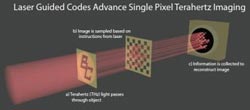Laser guided codes advance single pixel terahertz imaging

A new method for single pixel terahertz (THz) imaging developed by Boston College researchers uses a set of instructions delivered by a laser beam to tune THz waves in order to produce new types of THz images. During the imaging method devised by the team, THz waves pass through an object (a); then they strike a silicon semiconductor (b) given specific instructions about how to sample the image; that data is passed along in order to digitally reconstruct an image (c) of the original object in just a few seconds.<br><br>Credit: Claire M. Watts, Boston College<br>
The universe is awash in terahertz (THz) waves, as harmless as they are abundant. But unlike other regions of the electromagnetic spectrum, THz has proven to be extremely difficult to manipulate in order to capture novel images of objects and materials with which these light waves interact.
Most existing THz imaging devices employ prohibitively expensive technology or require several hours and cumbersome manual controls in order to generate a viable image, according to Boston College Professor of Physics Willie J. Padilla.
Padilla and researchers in his lab recently reported a breakthrough in efforts to create accessible and effective THz imaging. Using both optical and electronic controls, the team developed a single-pixel imaging technique that uses a coded aperture to quickly and efficiently manipulate stubborn THz waves, according to a recent report in the journal Optics Express.
In the so-called terahertz gap, a region of wavelengths that falls between microwave and infrared frequencies, conventional electronic sensors and semiconductor devices are ineffective. Some systems capture only a fraction of a scene and the means to tune these THz waves are inefficient. This has fueled the search for new imaging technologies in order to manipulate THz waves.
Efforts to overcome the challenges of mechanics, cost and image clarity are viewed as a crucial step in efforts to tame the THz gap since imaging and sensing at this frequency holds the potential for advances in areas as divergent as chemical fingerprinting, security imaging of hidden weapons, even real-time skin imaging to promote simple detection of skin cancer.
Central to this challenge is the development of a technology to create efficient masks – similar to the aperture of a camera — capable of tuning THz radiation in order to produce clear images in just a few seconds.
Padilla and graduate students David Shrekenhamer and Claire M. Watts report their new single pixel imaging method centers on what they describe as a “coded aperture multiplex technique” where a laser beam and electronic signals are used to send a set of instructions to a semiconductor so it can guide the reproduction of the image of an object after THz waves have passed through it.
A digital micro-mirror device encodes the laser beam with instructions that direct certain segments of the silicon mask to react and allow a selected sample of the THz waves to pass freely through, consistent with the image pattern. The combination of optical instructions and the reaction of the semiconductor create a THz spatial light modulator, the team reports. Functioning like the aperture of a conventional camera, the modulator then guides the digital reconstruction of the entire image based on a broad sampling of THz waves that have passed through the object.
The team's experiments found the method could produce masks of varying resolutions, ranging from 63 to 1023 pixels and acquire images at speeds up to .5 Hz, or about 2 seconds. The early findings “demonstrate the viability of obtaining real-time and high-fidelity THz images using an optically controlled SLM with a single pixel detector,” the team concluded.
Padilla said the findings have spurred additional research by his lab into ways to further control THz waves, such as by using the intricate patterns of an engineered metamaterial to further manipulate terahertz waves to create images faster and with increased efficiency.
Media Contact
More Information:
http://www.bc.eduAll latest news from the category: Physics and Astronomy
This area deals with the fundamental laws and building blocks of nature and how they interact, the properties and the behavior of matter, and research into space and time and their structures.
innovations-report provides in-depth reports and articles on subjects such as astrophysics, laser technologies, nuclear, quantum, particle and solid-state physics, nanotechnologies, planetary research and findings (Mars, Venus) and developments related to the Hubble Telescope.
Newest articles

Combatting disruptive ‘noise’ in quantum communication
In a significant milestone for quantum communication technology, an experiment has demonstrated how networks can be leveraged to combat disruptive ‘noise’ in quantum communications. The international effort led by researchers…

Stretchable quantum dot display
Intrinsically stretchable quantum dot-based light-emitting diodes achieved record-breaking performance. A team of South Korean scientists led by Professor KIM Dae-Hyeong of the Center for Nanoparticle Research within the Institute for…

Internet can achieve quantum speed with light saved as sound
Researchers at the University of Copenhagen’s Niels Bohr Institute have developed a new way to create quantum memory: A small drum can store data sent with light in its sonic…





















